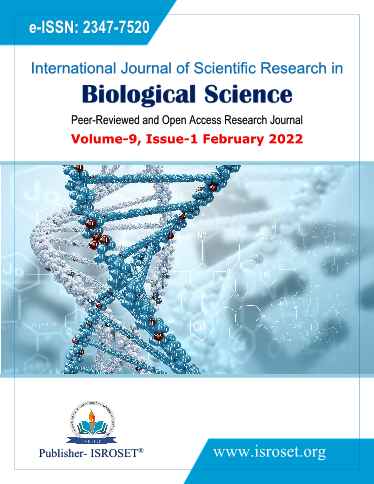Histopathological Changes Caused by Monochromatic Wavelengths in the Retina of Two Species of frogs
Keywords:
Retina, Monochromatic Wavelengths, Swamp Frog, Tree FrogAbstract
The current research deals with the study of the effect of monochromatic visible radiation on the retina of the eye, which are a beam of blue light whose wavelength ranges from 450-500 nanometers and intensity of illumination of 200 lux and under a temperature of 10oC in winter and 20? in summer, and a beam of yellow light whose wavelength ranges from From 550-600 nanometers, with an intensity of 225 lux, and under the same temperatures, for three months for each of the two lights. I took two types of frogs, the first is the swamp frog Rana ridibunda ridibunda and the second tree frog Hyla arborea savignyi. The effects in type 1 retina were generally greater than in type 2. On the other hand, the effects of blue light were more than yellow light in general, with close damage to the two lights in some cases, and the damage was at a high temperature of 20? more than at the temperature of 10? for the two types of light. The damage caused by monochromatic colors of visible light appeared to follow the wavelength, temperature, and intensity of illumination, as the shorter the wavelength, the higher the temperature and the higher the intensity of the illumination, the greater the damage to the components of the eye, and the absence of clots in the tissue of the eye indicates that the light damage occurred by the mechanism photochemical.
References
E. J. Warrant and N. A. Locket, Vision in the deep sea. Biol. Rev.,79, 671–712, 2004.
J. Viltala, E. Korpimaki, P. Palokangas, andM. Koivula, Attraction of kestrels to vole sent marks visible in ultraviolet detection. Nature 373, 425- 427, 1995.
F.T. Ollivier, D.A. Samuelson, D.E. Brooks, D.A. Lewis, M.E. Kallberg,. and A.M. Komaromy, Comparative morophology of the tapetum lucidum (among selected species) J. Comp.Anat., 7, 1, 11- 22, 2004.
J.Y. Lettvin, H.R. Maturana, W.S. Mcculloch, and W.H. Pitts, What the Frog`s eye tells the frogs brain, Martin Balaban, pp. 233- 258, 1968.
C. Morandini, Zoologia. S.A, fourth ed., Livraria Nobel,
pp. 137-218,1976.
H,A. Al-Hajj, Optical Microscopic Preparations (Microscopic Technologies) Theoretical Foundations and Applications, Jordan Book Center, Amman - Jordan, p. 331, 1998.
E. Gurr, Staining animal tissue, practical and theoretical. London, Leonard, Hill, p. 552, 1962.
A.G.E. Pears, Histochemistry theoretical and applied, 4th . ed., Analytical Technology, Churchill Living Stone, Edinburgh, p. 898,1985.
R.W. Young, Solar radiation and age-related macular degeneration. Surv. Ophthalmol., 32, 232-266, 1988.
D.T. Organisciak and B.S. Winkler, Retinal light damage: Practical and theoretical considerations. In progress in retinal and ocular research. (Eds. N. Osborne and G. Chader), pp.1-29,1994.
M. I. Glad Mohesh , Effect of high-intensity light on the retinal pigment epithelium of zebrafish – An induced retinal damage study model. National Journal of Physiology, Pharmacy and Pharmacology, 10,4,1-3, 2020.
T.S.H. Al-Fakji, A comparative microscopic study and the effect of some electromagnetic rays on the histological structure of the retina of two species of bony fish Calcalburnus mossulensis and Noemacheilus angora, Master Thesis, College of Education, University of Mosul-Iraq, 2003.
X. Ouyang, J. Yang, Z. Hong, Y. Wu, Y. Xie, G. Wang, Mechanisms of blue light-induced eye hazard and protective measures: a review. Biomedicine & Pharmacotherapy, 130,1-8, 2020.
C. Grimm, C.E. Reme and P.O. Rol, Blue light 146 effects on rhodopsin: Photoreversal of bleading in living rat eyes. Invest. Opthalmol, Vis. Sci., 41: 390-398,2000.
H. Siekman, Revision of guidelines on limits for laser radiation of wavelength between 400nm and 1400nm. International commission on non-ionizing radiation protection. Helathpysics., 45,431- 440,2000.
P.N. Youssef, N. Sheibani and D.M. Albert, Retinal light toxicity. Eye , 25, 1–14, 2011.
P. Ala- Laurila, R.J.Albert, P.Saarinen andA. Koskelainen, The thermal contribution to photoactivation in A2 Visual pigments studied by temperature effects on spectral properties. Vis. Neurosci., 20, 4 , 411-419, 2003.
D. Norren and J.J. Vos, Light damage to the retina: an historical approach. Eye , 30, 169–172, 2016.
I. Jaadane, G.V. Rodriguez1, P. Boulenguez, S. Carré2, I. Dassieni , C. Lebon, S. Chahory, F. Behar-Cohen1, C. Martinsons and A.Torriglia, Retinal phototoxicity and the evaluation of the blue light hazard of a new solid-state lighting technology. Scientific Reports , 10, , 6733 ,2020.
R.W. Young, The family of sun light related eye diseases, Review. Ophtomet. Vis. Scien., 71, 125- 144,1994.
Downloads
Published
How to Cite
Issue
Section
License

This work is licensed under a Creative Commons Attribution 4.0 International License.
Authors contributing to this journal agree to publish their articles under the Creative Commons Attribution 4.0 International License, allowing third parties to share their work (copy, distribute, transmit) and to adapt it, under the condition that the authors are given credit and that in the event of reuse or distribution, the terms of this license are made clear.







